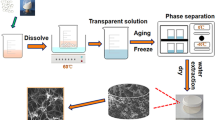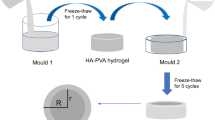Abstract
Nano-hydroxyapatite reinforced poly(vinyl alcohol) gel (nano-HA/PVA gel) composites has been proposed as a promising biomaterial, especially used as an articular cartilage repair biomaterial. In this paper, nano-HA/PVA gel composite was prepared by in situ synthesis method and incorporation with freeze-thaw cycle process. The microstructure and morphology were investigated by X-ray diffraction, TEM, SEM and FTIR. The results showed that the size of HA particles synthesized in PVA solution was on the nanometer scale. Both the size and crystallinity of HA particles synthesized in PVA solution decreased compared with that of HA synthesized in distilled water. The nano-HA particles were distributed in PVA matrix uniformly due to the effect of PVA solution as a dispersant while low content of HA particles in the composites. On the contrary, with high content of nano-HA particles in the composites, the particles tended to aggregate. The result of FT-IR analysis indicated that the chemical bond between nano-HA particles and PVA matrix existed. The conformation and degree of tacticity of PVA molecule changed because of the addition of HA particles. Furthermore, the interfacial strength of the composites was improved due to the interaction between nano-HA particle and PVA matrix and this was beneficial to improving the mechanical properties of the composites.
Similar content being viewed by others
References
Rebeccah J C, Ott R D, David N K. Friction Characteristics of a Potential Articular Cartilage Biomaterial[J]. Wear, 2003 (25): 1 064–1 068
Shigo M, Katsuko S F, Takashi U, et al. Static and Dynamica Mechanical Properties of Extracellular Matrix Synthesized by Cultured Chondrocytes[J]. Mater. Sci. Eng. C, 2004(24): 425–429
Karen J L B, Scott P, James F K. Biomaterial Developments for Bone Tissure Engineering[J]. Biomaterials, 2000 (21): 2 347–2 359
Pan Y S, Xiong D S, Chen X L. Friction Characteristics of Poly (Vinyl Alcohol) Hydrogel as an Articular Cartilage Biomaterial[J]. Key Eng. Mater., 2007 (330–332): 1 297–1 300
Noguchi T, Yamamuro T, Oka M. Poly (Vinyl Alcohol) Hydrogel as an Artificial Articular Cartilage: Evaluation of Biocompatibility[J]. Appl. Biomaterials, 1991, 2(2): 101–107
Pan Y S, Xiong D S. Recent Development on Biotribology of Poly (Vinyl Alcohol) Hydrogel[J]. Tribology, 2006, 26(2): 188–192 (in Chinese)
Suciu A N, Iwatsubo T, Matsuda M. A Study upon Durability of the Artificial Knee Joint with PVA Hydrogel Cartilage[J]. JSME, Part C, 2004, 47(1): 199–208
Stammen J A, Williams S, Ku D N. Mechanical Properties of a Novel PVA Hydrogel in Shear and Unconfined Compression[J]. Biomaterials, 2001 (22): 799–806
Ahn E S, Gleason N J, Nakahira A. Nanostructure Processing of Hydroxyapatite-based Bioceramics[J]. Nano Letter, 2001, 1(3): 149–153
Rosa R, Finizia A, Claudio D R, et al. X-ray Diffraction Analysis of Poly (Vinyl Alcohol) Hydrogels, Obtained by Freezing and Thawing Techniques[J]. Macromolecules, 2004 (37): 1 921–1 927
Rusu V M, Ng C H, Wilke M, et al. Size-controlled Hydroxyapatite Nanoparitcles as Self-organized Organic-inorganic Composite Materials[J]. Biomaterials, 2005 (26): 5 414–5 426
Nebahat D, Dilhan M K, Elvan B. Biocomposites of Nanohydroxyapatite with Collagen and Poly (Vinyl Alcohol)[J]. Colloids and Surfaces B: Biointerfaces, 2006 (48): 42–49
Liu Y K, Houm D D, Wang G H. A Simple Wet Chemical Synthesis and Characterization of Hydroxyapatite Nanorods[ J]. Mater. Chem. Phys., 2004 (86): 69–73
Niu L T, Liu J X, Zhou J, et al. Preparation and Characterizaiton of Hydroxyapatite Extr-fine Powder by Using Polyvinyl Alcohol as Organic Modifier[J]. Dalian Institue of Light Industry, 2004, 23(4): 239–241 (in Chinese)
Sahai N, Tossell J A. Molecular Orbital Study of Apatite (Ca5(PO4)3OH) Nucleation at Silica Bioceramic Surfaces[J]. Phys. Chem. B, 2000, 104(18): 4 322–4 341
Suprabha N, Arvind S. Systematic Evolution of a Porous Hydroxyapatite-Poly(vinylalcohol)-Gelatin Composite [J]. Colloids and surfaces B: Biointerfaces, 2004 (35): 29–32
Chang M C, Tanaka J. FT-IR Study for Hydroxyapatite/Collagen Nanocomposites Cross-linked by Glutaraldehyde[ J]. Biomaterials, 2002 (23): 4 811–4 818
Chang M C, Ko C C, Douglas W H. Preparation of Hydroxyapatite-Gelatin Nanocomposites[J]. Biomaterials, 2003, 24(17): 2 853–2 862
Author information
Authors and Affiliations
Corresponding author
Additional information
Funded by the Natural Science Research of Key Projects of Anhui Provincial Universities (No. KJ2010A099).
Rights and permissions
About this article
Cite this article
Pan, Y., Xiong, D. Preparation and characterization of nano-hydroxyapatite/polyvinyl alcohol gel composites. J. Wuhan Univ. Technol.-Mat. Sci. Edit. 25, 474–478 (2010). https://doi.org/10.1007/s11595-010-0026-y
Received:
Accepted:
Published:
Issue Date:
DOI: https://doi.org/10.1007/s11595-010-0026-y




